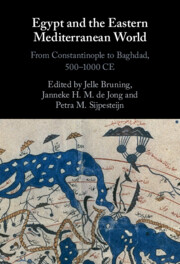Book contents
- Egypt and the Eastern Mediterranean World
- Egypt and the Eastern Mediterranean World
- Copyright page
- Contents
- Figures, Graphs, and Tables
- Notes on Contributors
- Notes on Transliteration, Names, and Dates
- Preface and Acknowledgments
- Additional material
- Introduction
- Part I Political and Administrative Connections
- Part II Economic Connections
- Chapter 7 Between Ramla and Fusṭāṭ: Archaeological Evidence for Egyptian Contacts with Early Islamic Palestine (Eighth–Eleventh Centuries)
- Chapter 8 Egypt’s Connections in the Early Caliphate: Political, Economic, and Cultural
- Chapter 9 Trading Activities in the Eastern Mediterranean through Ceramics between Late Antiquity and Fatimid Times (Seventh–Tenth/Eleventh Centuries)
- Part III Social and Cultural Connections
- Index
- References
Chapter 7 - Between Ramla and Fusṭāṭ: Archaeological Evidence for Egyptian Contacts with Early Islamic Palestine (Eighth–Eleventh Centuries)
from Part II - Economic Connections
Published online by Cambridge University Press: 01 December 2022
- Egypt and the Eastern Mediterranean World
- Egypt and the Eastern Mediterranean World
- Copyright page
- Contents
- Figures, Graphs, and Tables
- Notes on Contributors
- Notes on Transliteration, Names, and Dates
- Preface and Acknowledgments
- Additional material
- Introduction
- Part I Political and Administrative Connections
- Part II Economic Connections
- Chapter 7 Between Ramla and Fusṭāṭ: Archaeological Evidence for Egyptian Contacts with Early Islamic Palestine (Eighth–Eleventh Centuries)
- Chapter 8 Egypt’s Connections in the Early Caliphate: Political, Economic, and Cultural
- Chapter 9 Trading Activities in the Eastern Mediterranean through Ceramics between Late Antiquity and Fatimid Times (Seventh–Tenth/Eleventh Centuries)
- Part III Social and Cultural Connections
- Index
- References
Summary
The swift Arab conquest of Palestine, Syria, and Egypt, between 633 and 643 CE, triggered long-term processes of change in the region, among them the introduction of new settlement structures, architectural concepts, and patterns of commercial exchange. A gradual transformation in types of pottery, glass, and metal vessels has been observed, including the development of new types and technologies. The archaeological record indicates that large regions in the Near East benefited from the establishment of the new Muslim empire, which was also expressed in the intensification of commercial contacts, particularly between Egypt, Palestine, and Syria.1
This chapter addresses the intensified connectivity between Palestine and Egypt after the Arab conquests on two main levels. First, artifacts are presented as indicators of commercial contacts and of the movement of people. Numerous excavations in modern Israel, the Palestinian Authority, Jordan, and Syria have yielded artifacts manufactured in Egypt or presenting Egyptian influences in style and production, such as pottery, glass and metal vessels, jewelry, and textiles.
- Type
- Chapter
- Information
- Egypt and the Eastern Mediterranean WorldFrom Constantinople to Baghdad, 500-1000 CE, pp. 205 - 237Publisher: Cambridge University PressPrint publication year: 2022



